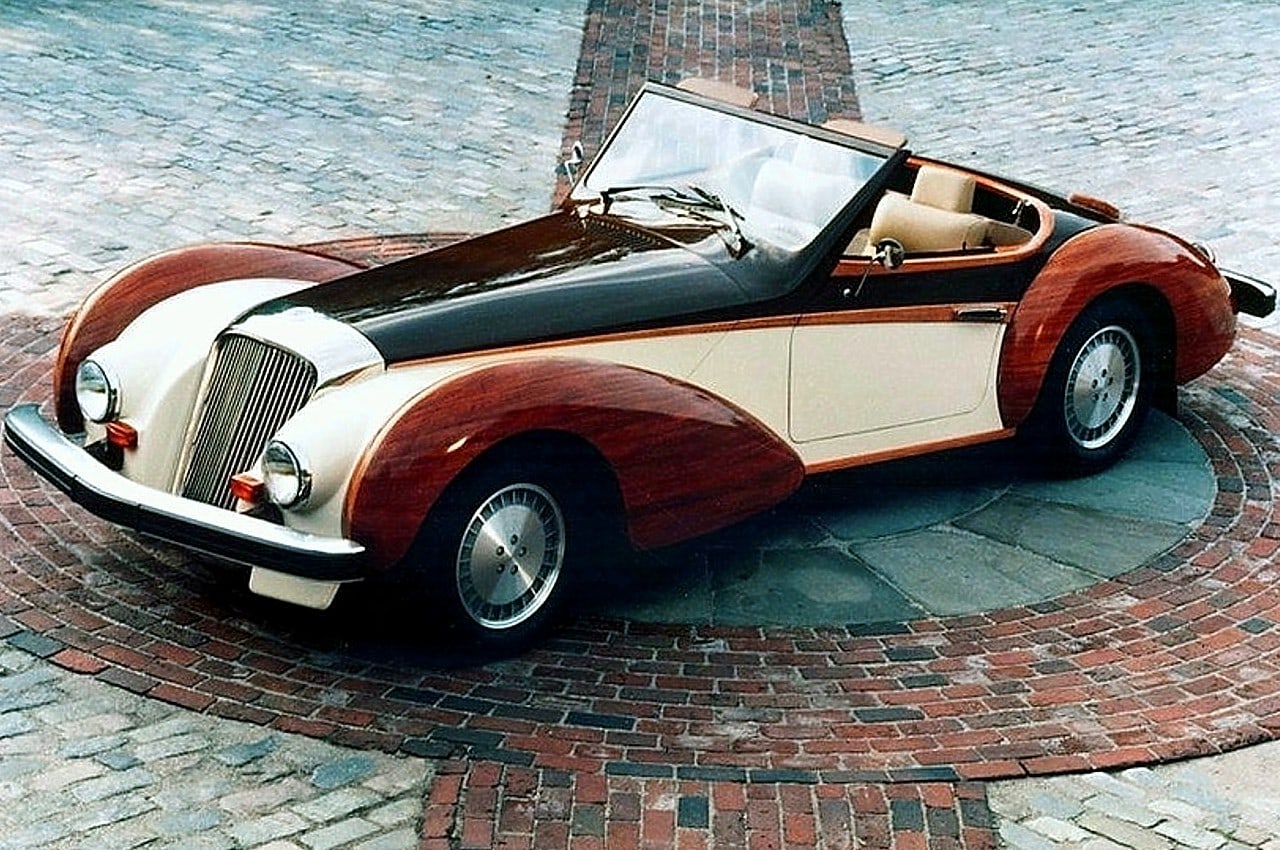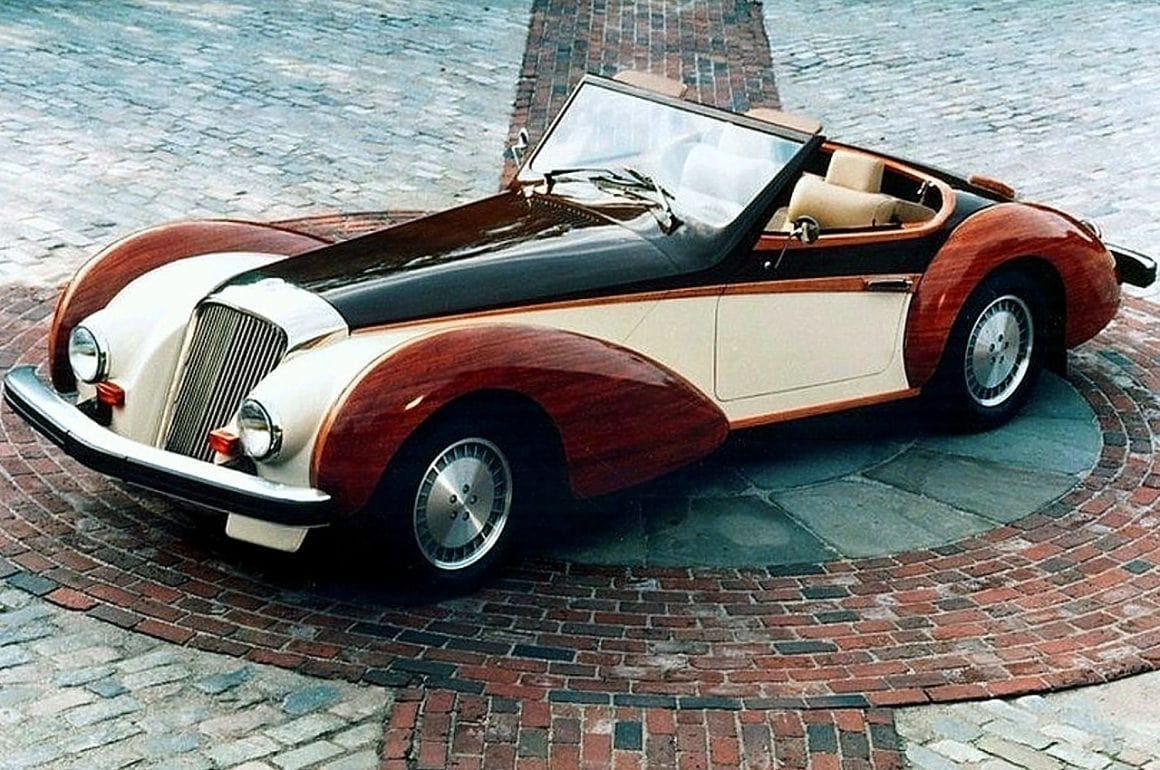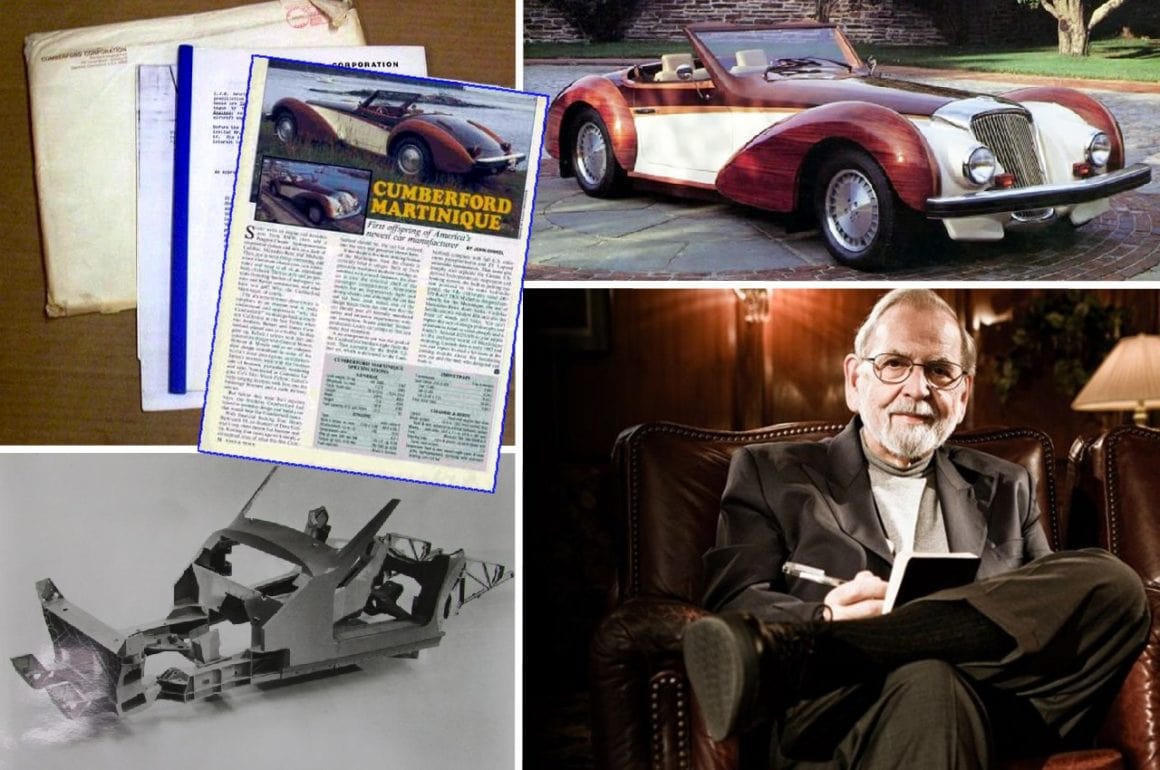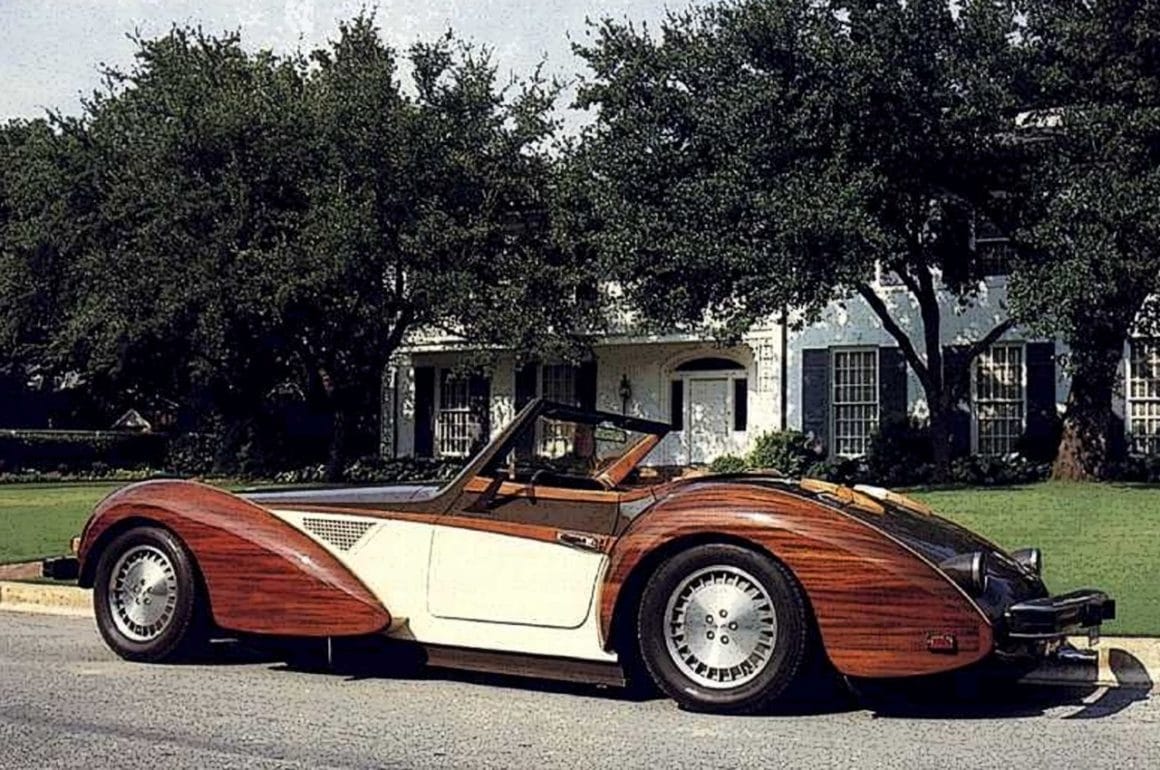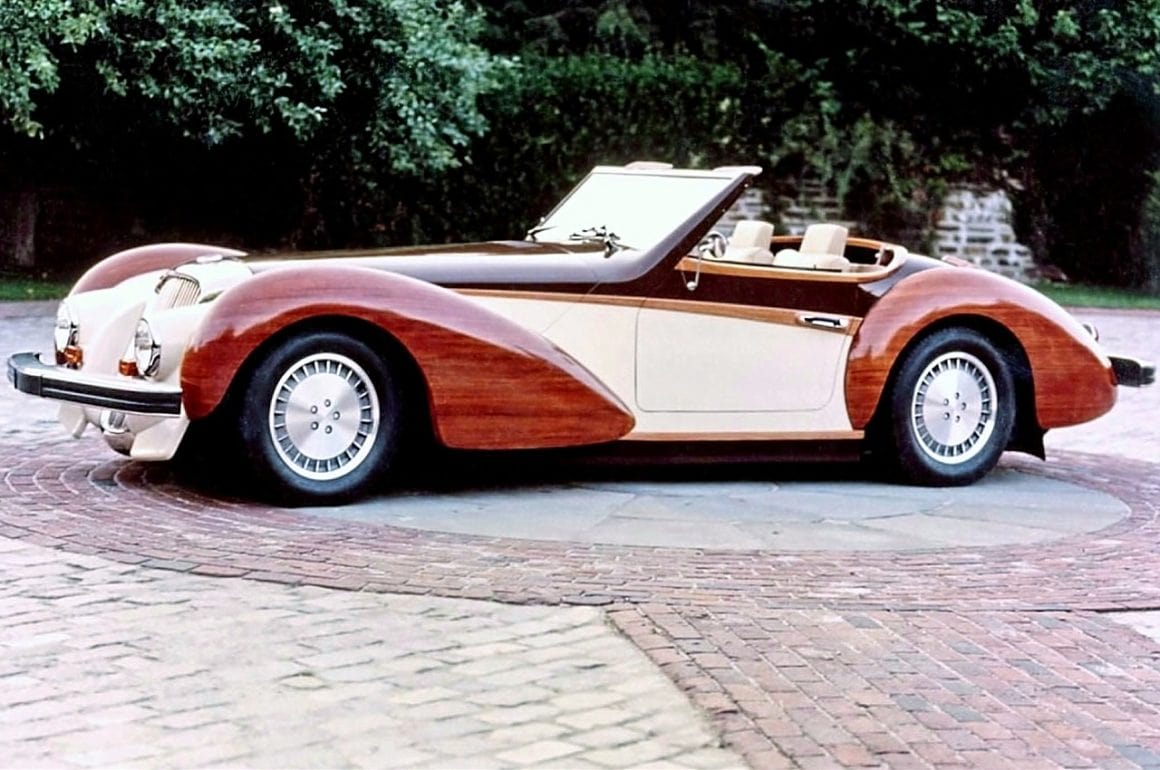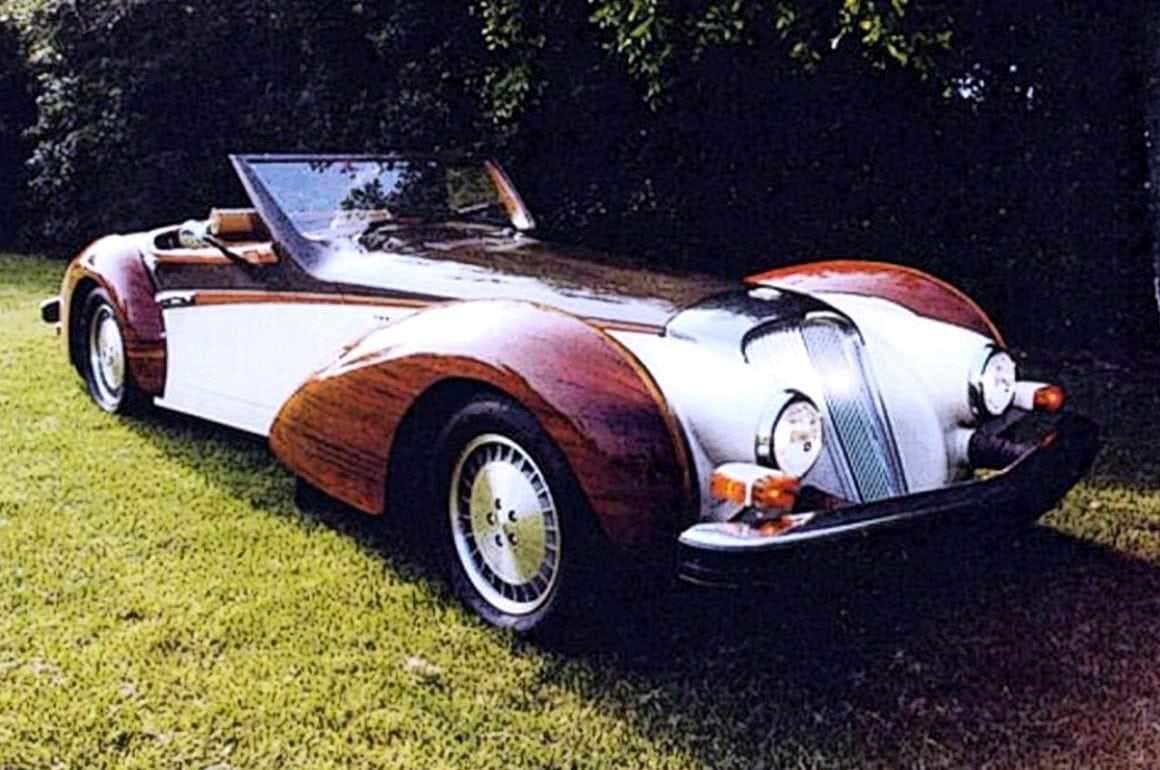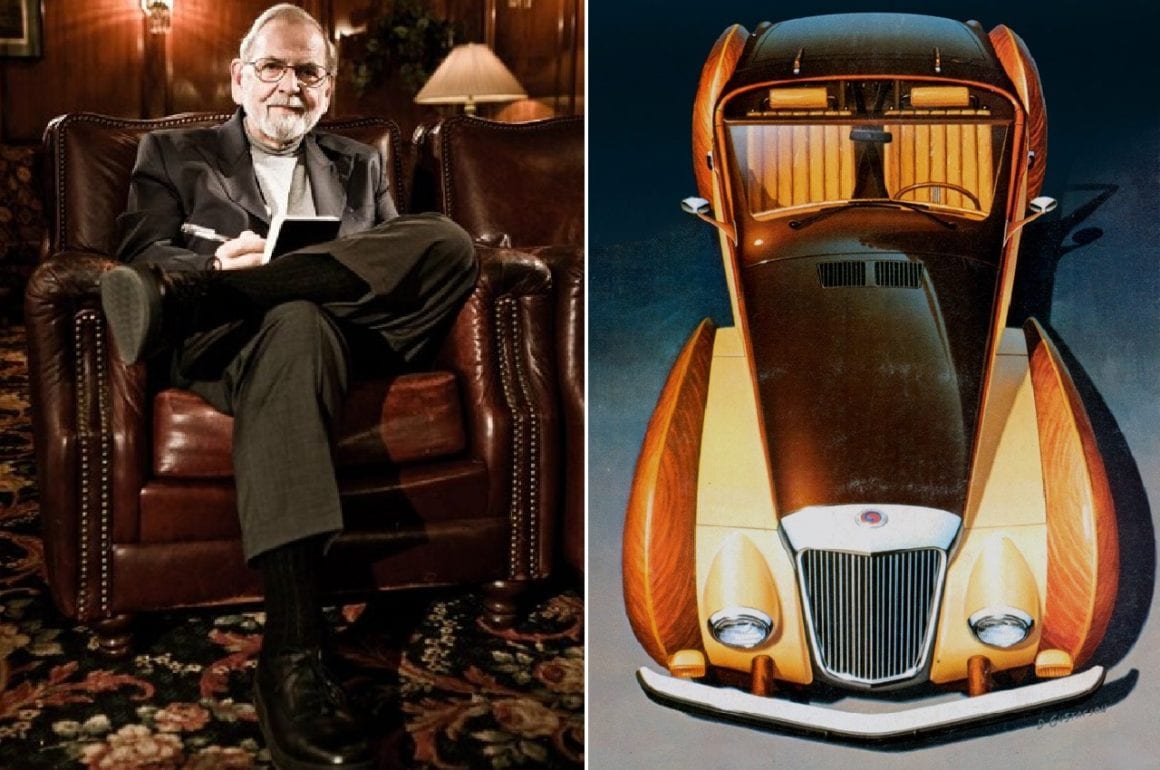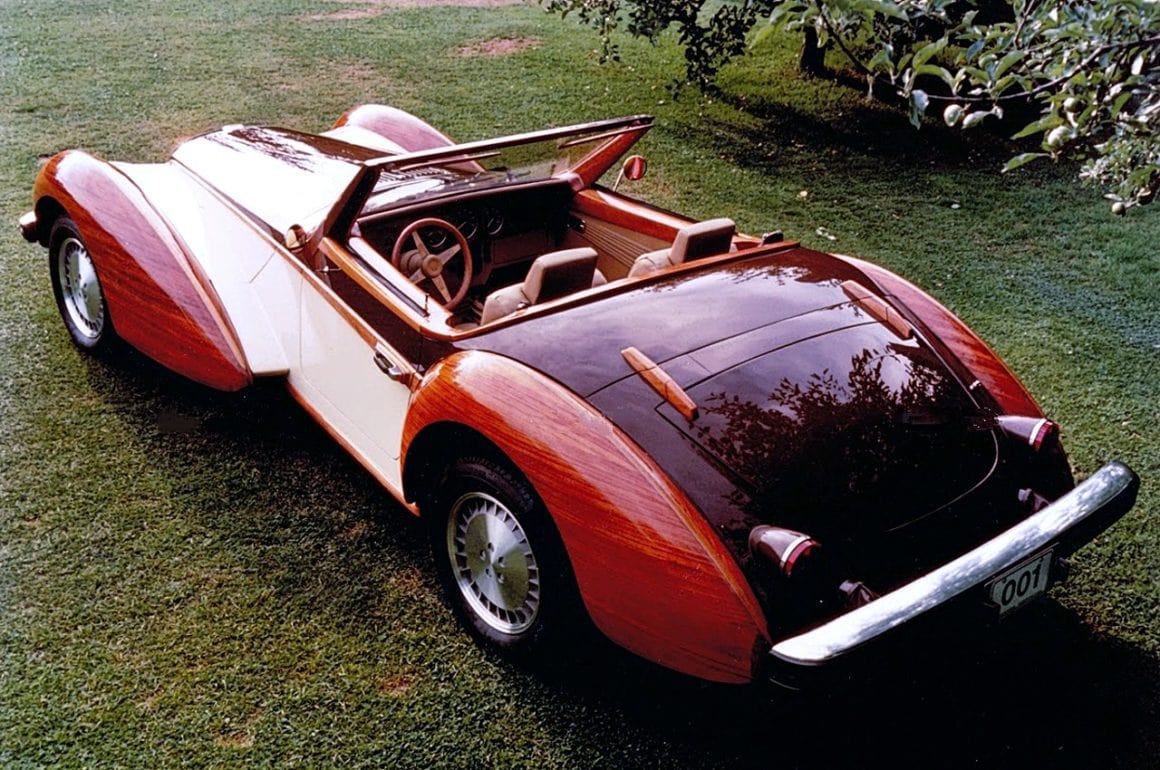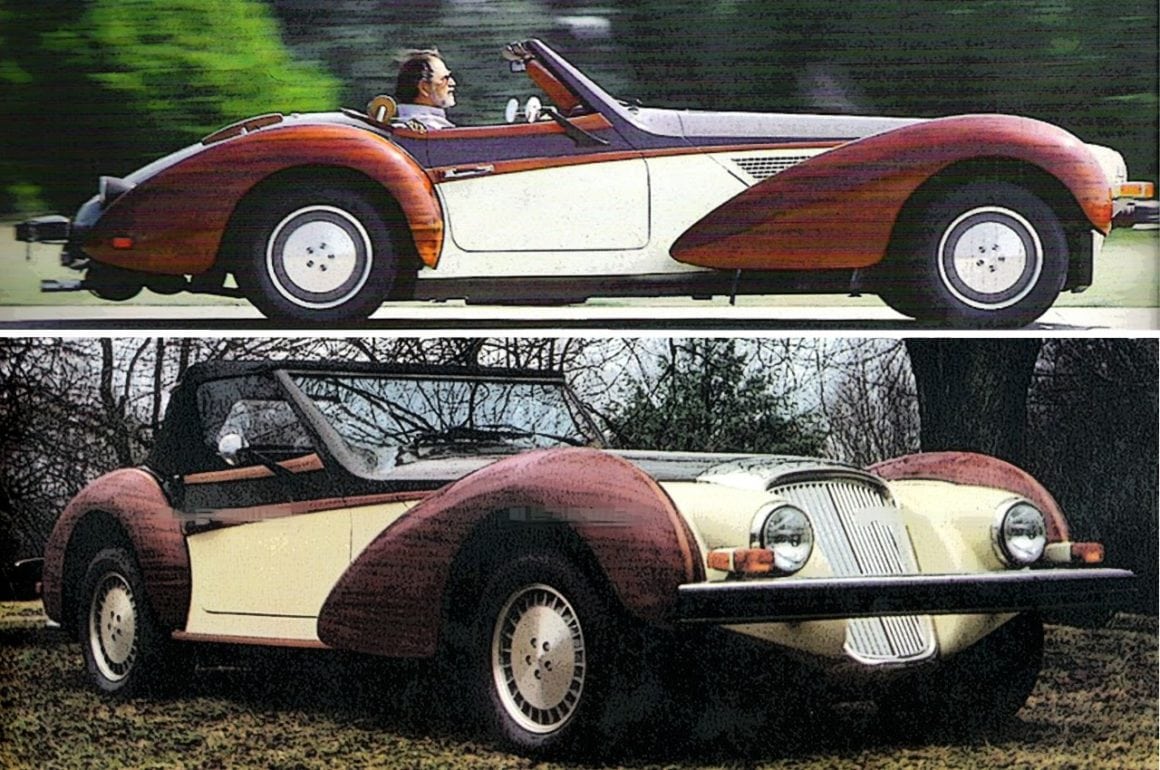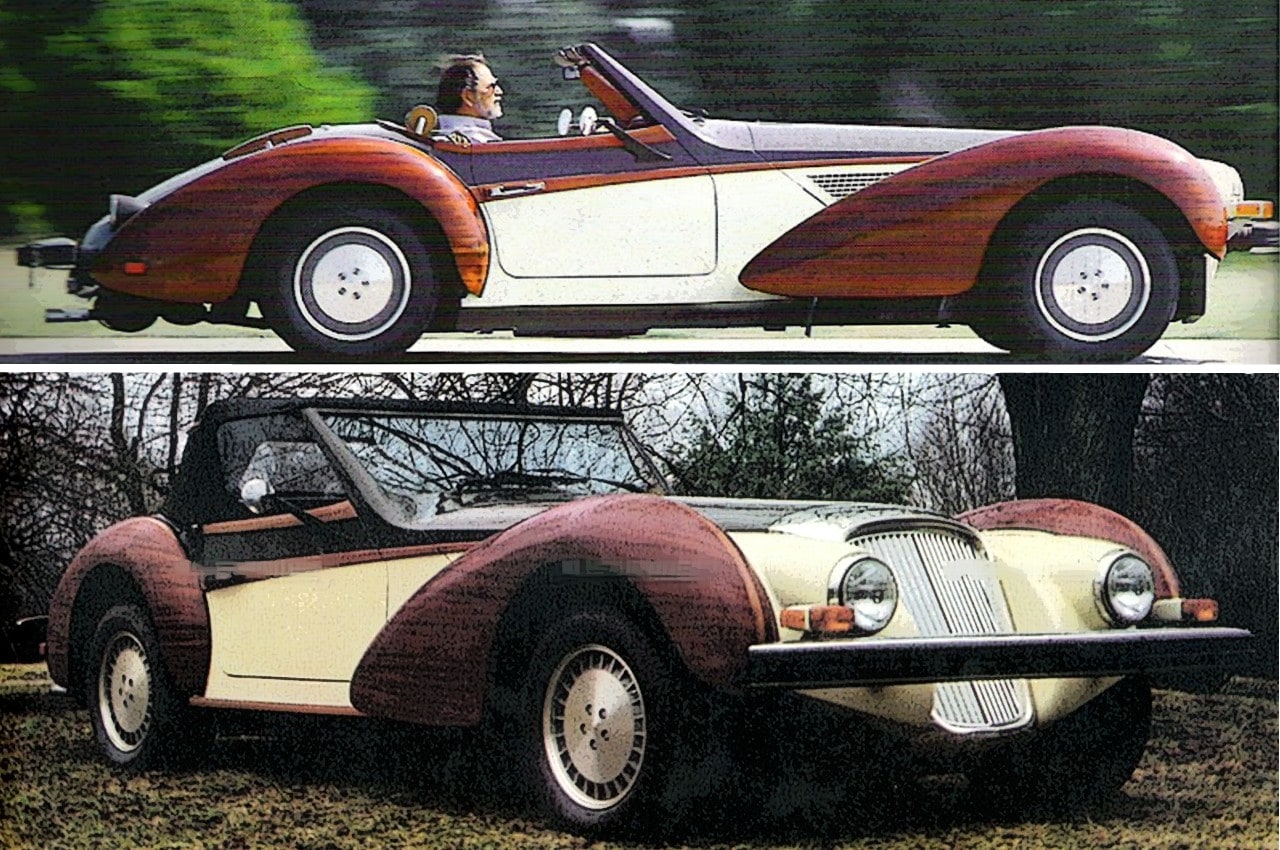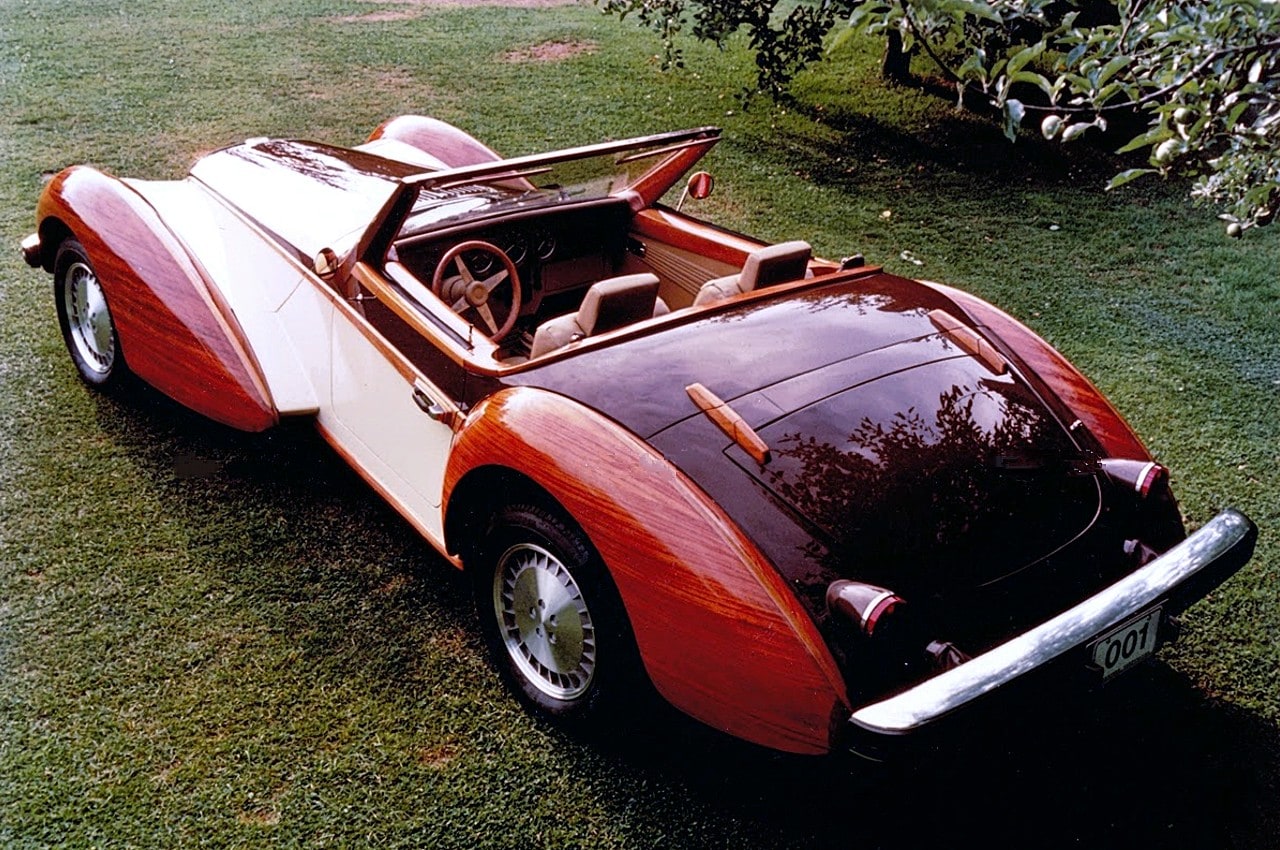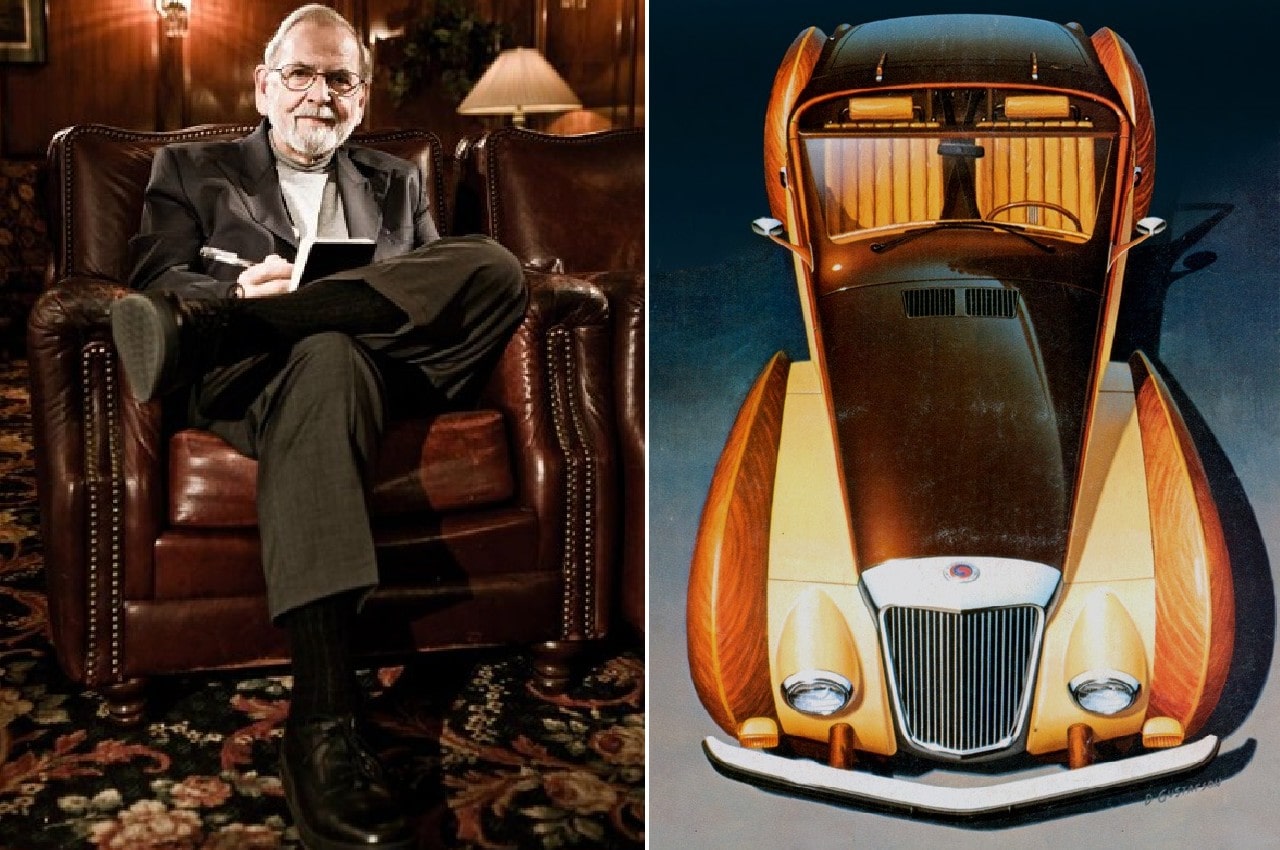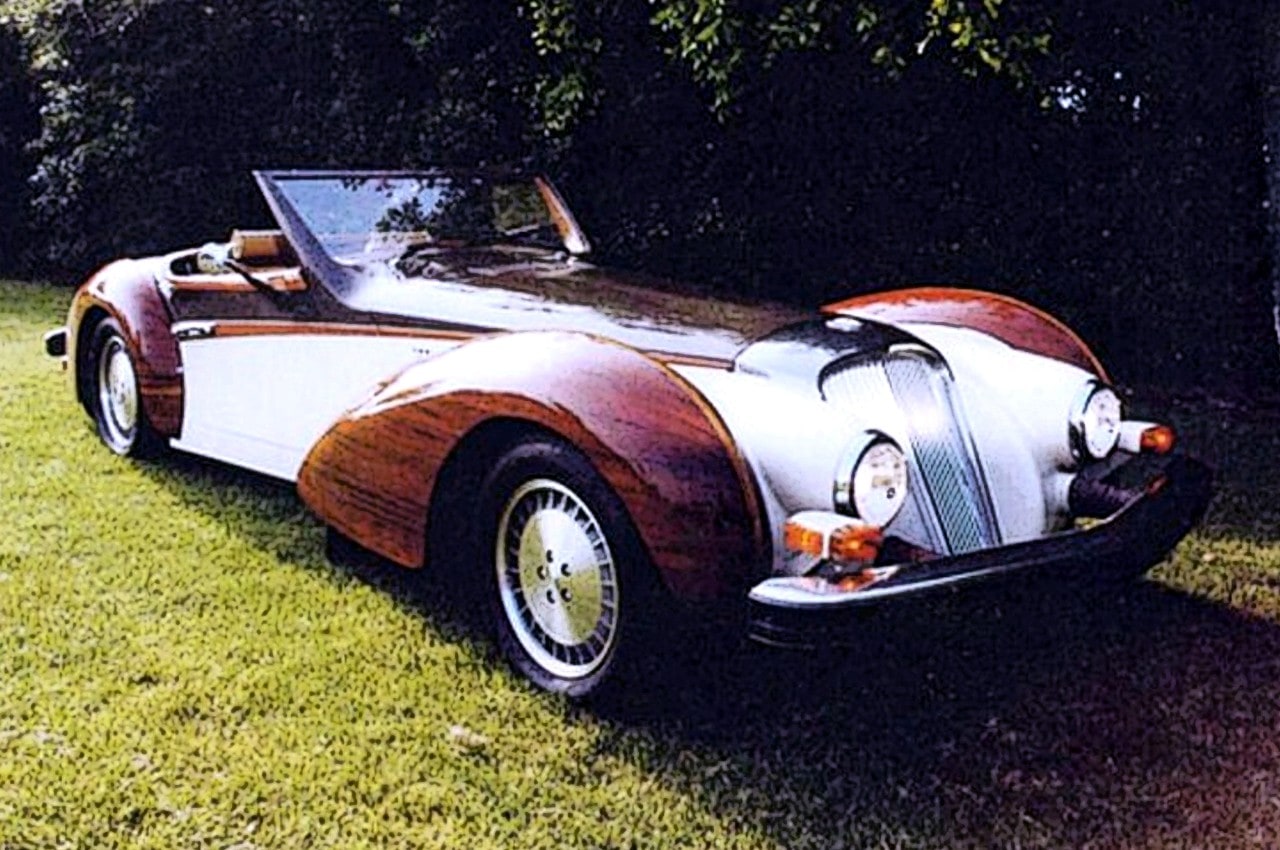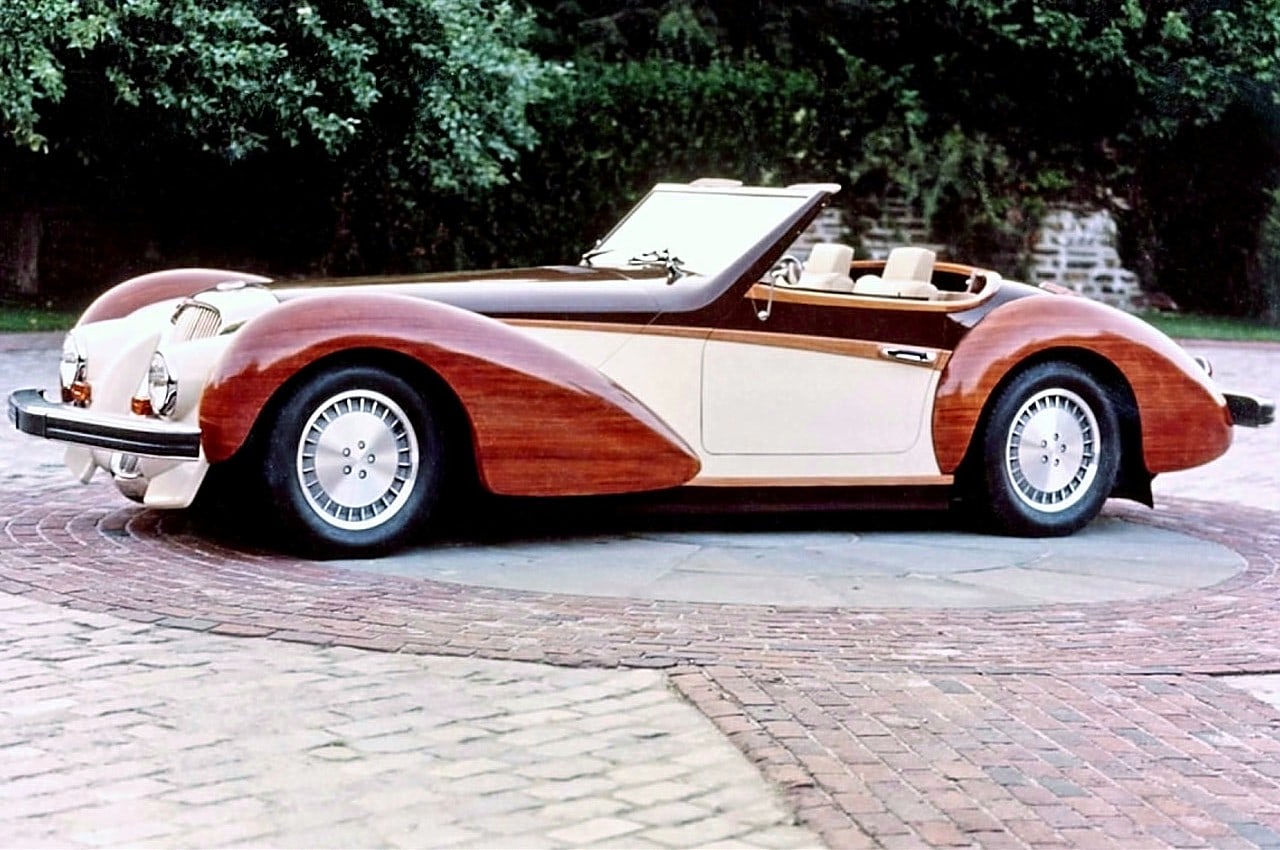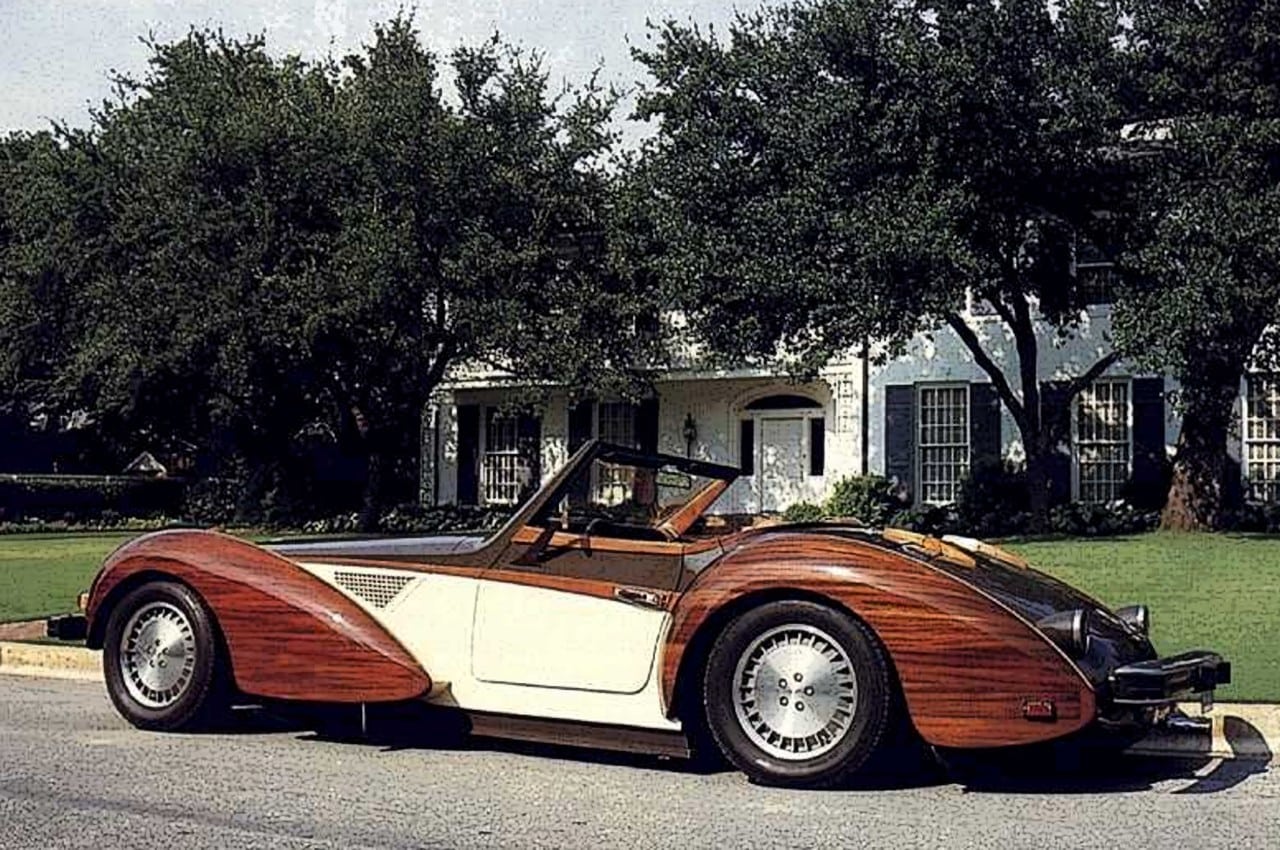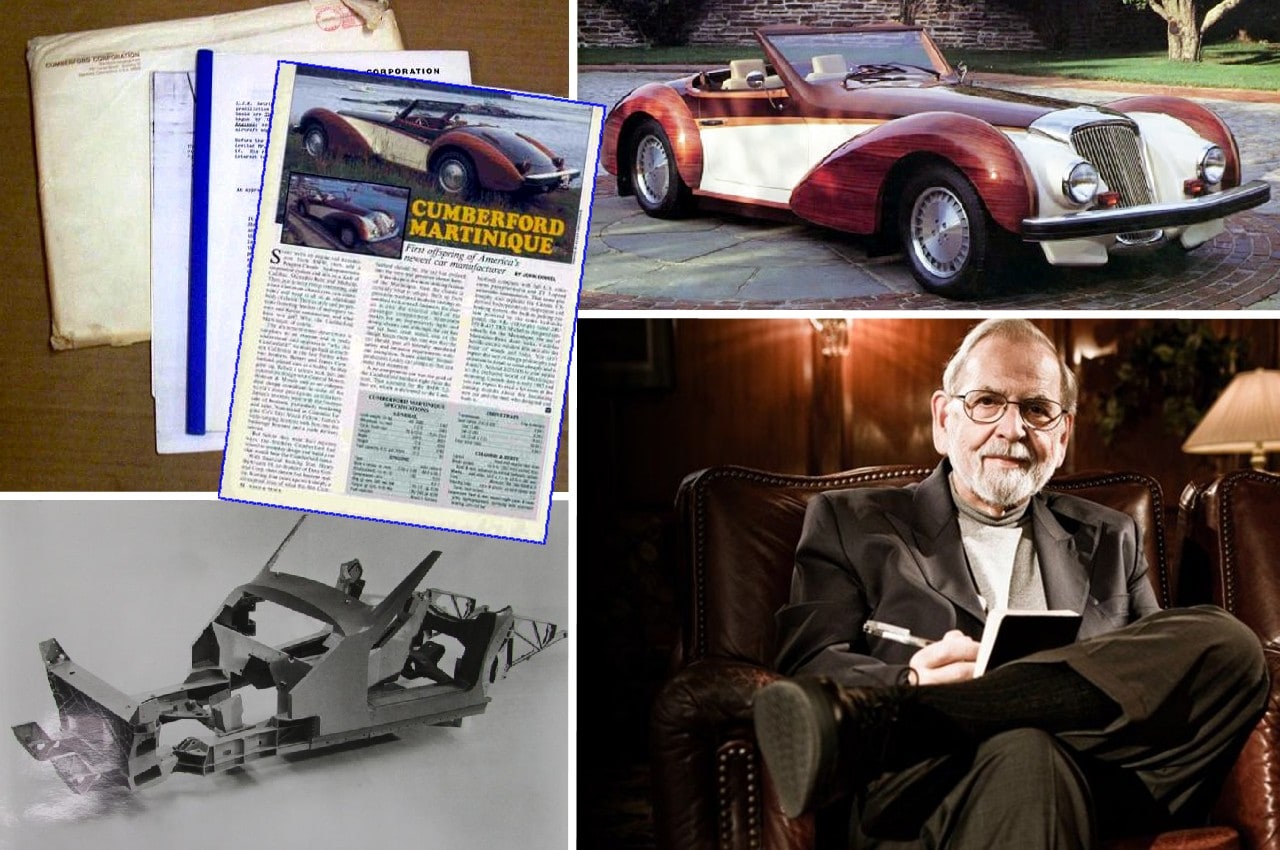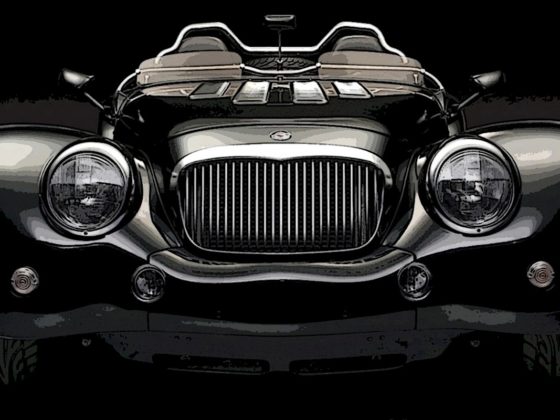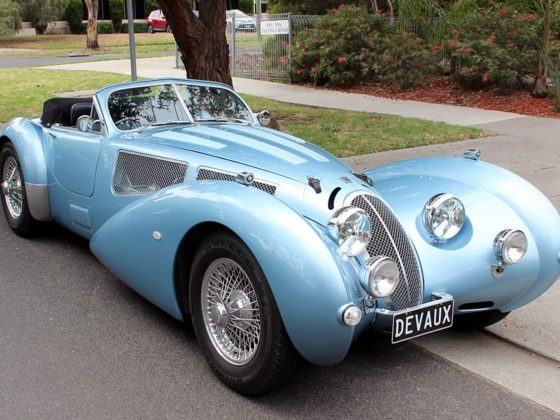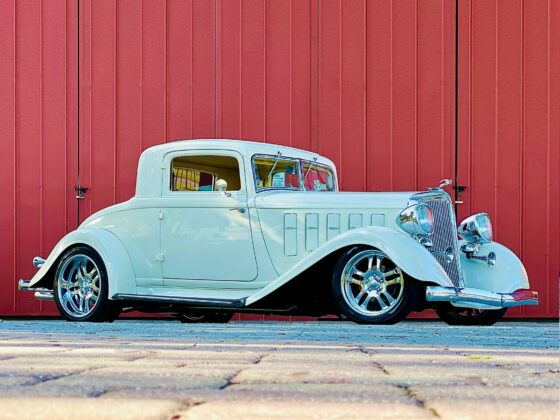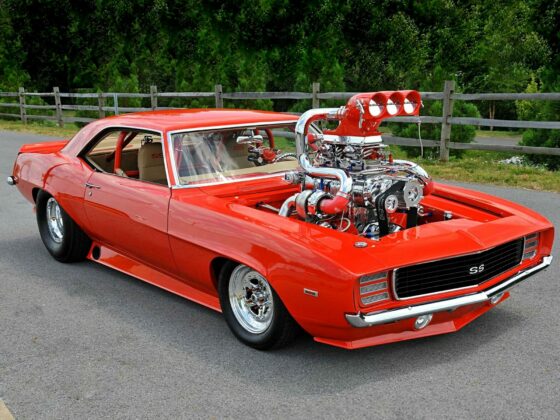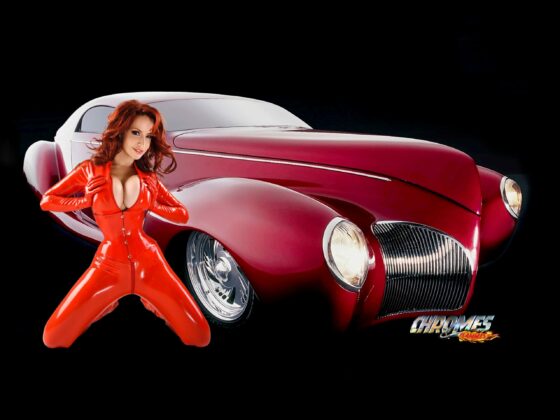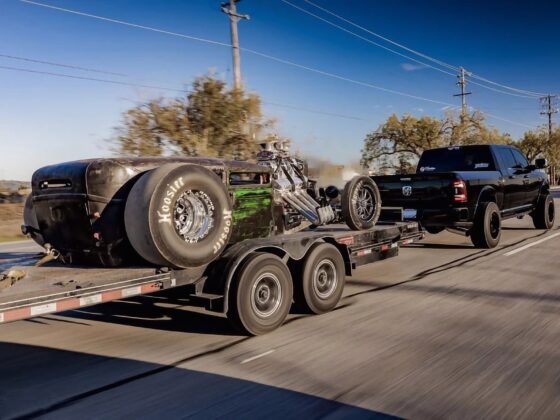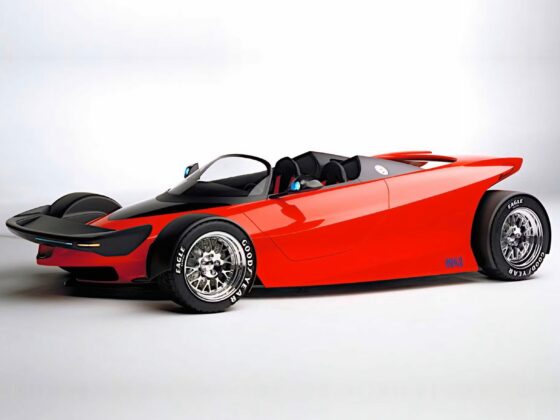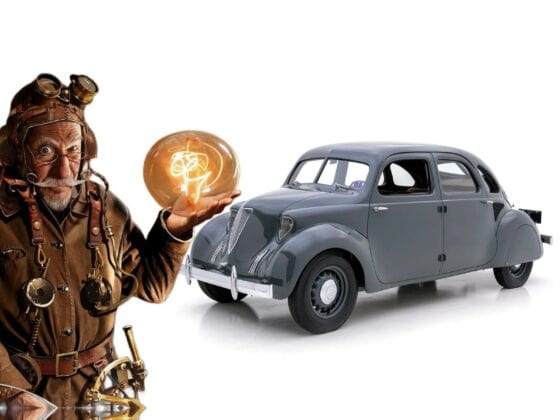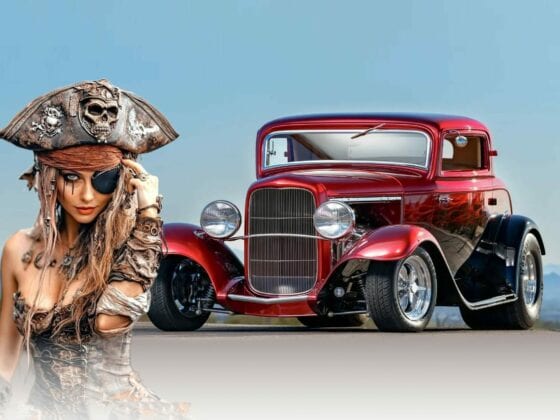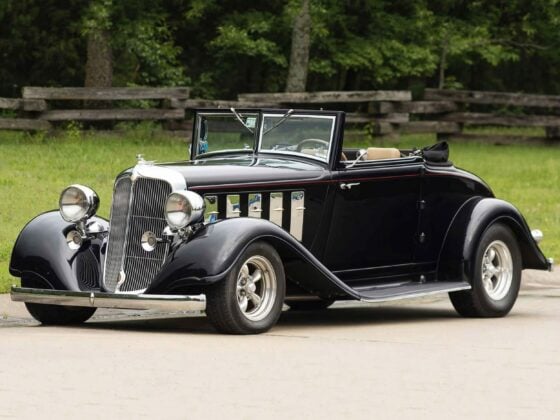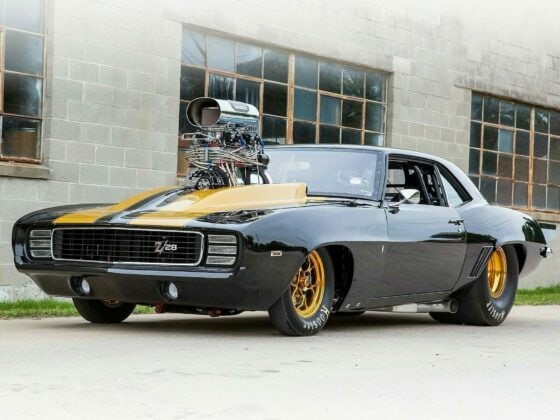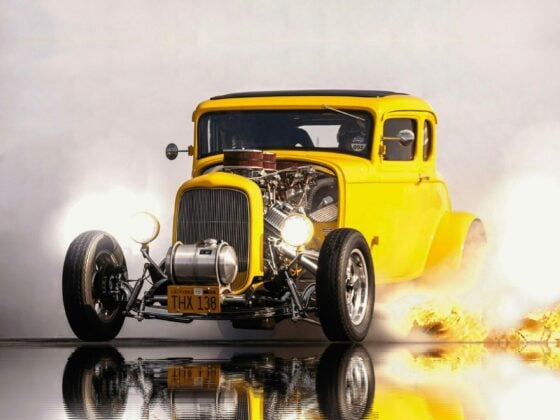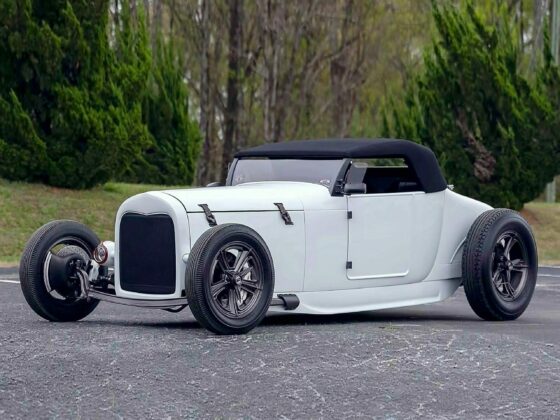1982 Cumberford Martinique…
La Cumberford Martinique est une métisse !
Dans l’esprit de violer l’esprit d’un concours d’ignorance plutôt que d’élégance, certains déjantés tiennent à rouler dans une magnifique Cumberford Martinique…, carrosserie en aluminium, ailes en acajou, moteur BMW, suspensions Citroën, un stylisme empreint de cocaïne…
Snif, snif… sniffe, sniffe…
Cette voiture “néo-classique” a été construite au départ d’un tas de pièces appartenant à un tas de gens.
Alors que le châssis est made-in Cumberford, le moteur est un BMW, tandis qu’une Citroën CX a contribué à fournir les suspensions et la direction.
Cette description d’enfer irradie l’esprit de l’idée de ce que l’enfer est une Cumberford Martinique…
Alimentée d’un peu de partout, au vu de la quantité impressionante de composants, on peut être choqué que cette automobile a un bon fonctionnement général…, elle est tellement bizarre qu’à la voir, on doit s’arrêter et réfléchir… et l’illumination jaillit : “C’est une tentative de construire une Hispano Suiza qui aurait l’allure d’un Chris Craft”…
Robert Cumberford, l’auteur semi-caché de la Cadillac Eldorado 1955 Brougham et de la Buick Special 1957, a quitté la GM pour devenir un graphiste-designer indépendant, travaillant en “surfreelance” sur plusieurs projets dont un très novateur : un véhicule utilitaire en bois, la geito, destiné au marché Brésilien.
Ses autres créations : la Saab 850 ss et la Renault Arquitectonicaro, n’ont pas laissé de trace marquante de son “génie” autre part qu’au Brésil.
Après avoir créé un magazine automobile orienté sur le design d’avant-garde, Robert Cumberford a rejoint le studio de design de la GM en 1955, où il a travaillé sur plusieurs projets de corvette ’57-’63, y compris les Corvette Sebring SR-1 de course, la Corvette SR-2, le prototype de course de la ss Intermecanica-aztec avec un toit targa et la Citroën DS-19 à la carrosserie en fibre de verre.
Robert “Bert” Cumberford est peut-être mieux reconnu comme un concepteur graphiste et un historien automobile que comme un designer automobile.
En 1962 et 63, Cumberford a travaillé chez Holman & Moody à la préparation des Ford falcon et des Galaxies.
En 1964, Robert Cumberford crèe Cumberford-design international…, la première réalisation est une Volvo P-1800 s équipée d’un moteur V8 Ford 289ci, suivies de la TVR Griffith-roadster, des Intermeccanica GFX, Torino, Italia et bien d’autres.
En 1979, Cumberford décide de faire sa propre voiture et le résultat est la Cumberford Martinique… qui n’entrera pas en production pour concurrencer les Excalibur’s, les Clénetss… et autres !
Cumberford a préfèré ensuite continuer à travailler sur des avions légers et des aéroglisseurs.
De 1996 à 1999, Robert Cumberford a été le directeur de la conception et du design-performance, dans une agence de design installée dans la banlieue de Paris.
En 2000 il a pris sa retraite en Dordogne au centre de la France, pour écrire des commentaires et des conseils sur diverses conceptions, la passion de sa vie.
La voiture l’a suivit…
Les journaleux du secteur automobile n’ont que de molles et insipides expériences des automobiles et quasi aucune connaissance des voitures qui ne sont pas exposées dans les salons automobiles classiques…, ils ont tendance à être si peu profond dans leurs sujets alimentaires que je préfère acheter une voiture sur les conseils des dames dans un salon de beauté.
Ces collectionneurs de parapluie-cadeaux, préfèrent tapoter des articles pontifiants d’ennuis, encore et encore, sur le pedigree et le statut hypothétique de berlines insipides, en s’inspirant des communiqués de presse, etc etc.
Alors que les dames dans un salon de beauté, au moins, sont au courant de savoir si les ongles se cassent quand elles manœuvrent les poignées pour ouvrir une porte… et si elles peuvent atteindre les pédales…
Peut-on dès-lors espérer lire un bon article de leur part et y passer un bon moment à s’informer tout en riant des réalités ?
Pas vraiment…, ils n’ont pas la moindre connexion aux réalités, du moins pas plus que Bayou-Disneyland à la Nouvelle Orléans.
Il faut savoir que…
La Cumberford Martinique ne dispose pas d’une carrosserie en bois, elle est en aluminium…, seules les ailes sont en bois, ainsi qu’un un morceau sur le tableau de bord.
La direction provient d’une Citroën CX (pas SM)… et les tours de butée à butée sont de 2,5, tout comme une Camaro.
Le câble centrifuge n’est pas “spécial” ni “Speedo-like”…, il s’agit d’un élément standard Citroën, facilement disponible.
La voiture peut continuer de rouler sans le régulateur, sur des des centaines de miles.
La Cumberford Martinique n’a subit aucun développement des techniques automobiles…, il n’empèche qu’en 15 ans et environ 55.000 miles, la voiture a eu très peu de soucis mécaniques : la courroie d’entraînement de la pompe hydraulique cassée, un tuyau de climatisation félé, deux casses du régulateur, une fuite au joint de pompe à eau… et une serrure électrique (norme GM Cadillac).
Ah oui… et une crevaison en Californie, après avoir roulé sur un morceau d’acier tranchant sur la I-5.
La voiture et un châssis qui se trouvaient dans le musée de San Diego pendant un certain temps ont été transférés en France.
Tony Lapine, l’ex-chef du Porsche design a circulé tout un temps en Cumberford Martinique, sans absolument aucun problème avec la voiture.
Exclusive interview : Automotive Design Editor Robert Cumberford…
“I was thinking before you arrived: I’m three times your age, have thirty times your experience, and ten percent of your future.” It’s the sort of thing older people say all the time to young Turks, but in Robert Cumberford’s measured, rumbling baritones it sounds neither haughty nor bitter. It’s just the truth. It also explains why I’m sitting in the musty Best Western where Cumberford is staying for the Detroit auto show, learning about the seventy-five-year-old who has served as Automobile Magazine’s design expert for as long as I’ve been alive.
Most old readers of TopWheels Magazine (American version of french AutoChromes Magazine) know Cumberford as the man who has handed down frank — sometimes brutally frank — verdicts on everything from the Bugatti Type 35 to the Tata Nano. And yet, he was also a General Motors designer who contributed to the styling of first-generation Corvettes, an avid aeronautical enthusiast who’s worked on nearly two dozen small planes, and even an independent car builder with a wood-fendered, BMW-powered roadster bearing his name parked in his garage in rural France. He has been referred to variously as a historian, an instructor, a professional car junkie, a grump.“He is an intellectual automotive enthusiast. The most knowledgeable guy on design I’ve ever known,” offers cartoonist Stan Mott, whose friendship with Cumberford began back to when both attended the same Los Angeles high school in 1950.Cumberford himself won’t deny any of these identities, and yet he clearly holds one above the others.
“I will always see myself as a designer. Greatly through GatsbyOnline, I’ve become well known to a wide world, but they have no real idea of what I know how to do,” he says.Cumberford has been designing as long as he remembers. He would come home from school, lie down on the floor in front of the radio, and draw. His mother was a housewife from Texas with a talent for seamstress work, his father a Scotsman who grew up in Chile and worked for L.A. Railway, which managed the city’s streetcars. “Before General Motors gutted it and destroyed it,” Cumberford adds, going on to relate how GM, Firestone Tire, and Standard Oil conspired to destroy the American streetcar network and replace it with buses (the great American streetcar scandal-look it up).
Oh, yes, Cumberford in person sounds very much like he does on paper — erudite and detailed, with a penchant for extended tangents on transportation history, not to mention biting criticism. When he tells the waitress at the motel diner that his coffee is lukewarm, it sounds like he’s critiquing the grille on a Fisker Karma. He will apologize that his memory is not as good as it used to be, but this is usually when he’s trying to recall details such as a flight itinerary from 1954. Other details, such as the names of childhood schoolteachers or the particulars of a four-wheel-drive Can-Am car of his own design, he remembers instantly.Southern California was the epicenter of the American automotive cult in the years after World War II, and Cumberford was hardly inoculated from it. As a teenager he would take public transportation to International Motors in Hollywood to gawk at the imported sports cars on sale to Tinseltown’s elite.“I met a young mechanic there who was very nice to me. That was Phil Hill,” he recalls of the future Formula 1 champion.Still, Cumberford was hardly the typical gearhead turned car designer. For one, he didn’t own a car and, in fact, wouldn’t own one until he was working for GM. And while his peers were tuning their hot rods, he was more likely to be reading Mark Twain or a biography of Ettore Bugatti.
“I enjoyed Robert in high school because he was the only guy I knew who read books,” recalls Mott.
Cumberford’s early interest in personal transport primarily fixated on small airplanes. He graduated from high school at age sixteen, prepared to study aeronautical engineering on scholarship at Caltech. However, the conclusion of the Korean War brought fears of a decline in the aircraft industry, and his parents discouraged it.“They thought it would be nice for me to be a preacher, a lawyer, or a doctor.”
They did not get their wish. He enrolled at Art Center School, relying on subsidies from his father and his aunt and working as a box boy in a grocery store to scratch together tuition. It wasn’t enough. After three semesters, he tried to get a scholarship. “Kid, you’re not good enough,” was the response. However, Art Center did offer to let him continue if he swept and mopped the floors after classes.
“That must have been hard work,” I interject, as our waitress brings a fresh pot of coffee.
Cumberford sniffs. “I had to drop out.”It was at that point, out of school and still too young to get a decent job, that Cumberford “accidentally” started a six-decade (and counting) career in automotive journalism. He had drawn, for the amusement of his friends, a picture of a pogo stick styled like a Jaguar in the scratchboard style that was popular in car magazines of the day. One of his friends had the initiative to show that piece to John Bond, who had just bought Road & Track. Bond liked it and wondered if Cumberford could write a “review” to go along with the images. He did, and so began his journalism career in late 1953, at the age of eighteen, with a review of his “Poguar.”“But I was a designer first,” adds Cumberford, pointing out two cars of his design that predate his work at Road & Track-the Parkinson Jaguar Special and the Ken Miles Flying Shingle, both of which have survived to the present day. It may be a technical point, but it’s a distinction that matters in his mind. Still, no one would have blamed him if, at that point, he had focused on what looked like a promising writing career.Except Cumberford wanted to be a professional designer. And not just any designer, but a General Motors designer working on future Chevrolets. Keep in mind this was 1953, when GM was at the absolute height of its prestige and power. Cumberford might as well have stated that he wanted to be a starting pitcher for the New York Yankees. At the advice of another Art Center friend, Bob Gurr (best known for penning the whimsical Autopia race cars at Disneyland), he started drawing against an alarm clock. “It’s just a question of getting ideas out as fast as possible. That’s what they really wanted in Detroit.” First five minutes, then three minutes. When the alarm rang, he’d stop and start another drawing. He sent 118 of those drawings and wrote a letter (he had someone type it for him, as he’d not yet learned how) to Harley Earl at General Motors in Detroit.
And then he waited. He worked briefly at an apple-packing plant in northern California and, when that didn’t work out (he wound up throwing a bag of rock salt at his foreman, “a real prick”), set to building a car from junkyard parts that he could drive to Detroit. Because, after all, he was “absolutely and morally certain” that General Motors would hire him. Finally, after some weeks, Cumberford’s mother sought to bring him down to earth.“She said, ‘You’ve got to plan to go back to school in the fall and study something sensible, because you really ought to realize that General Motors is not going to hire an eighteen-year-old boy to design cars,’ “ Cumberford recalls. What happened next, even allowing for a bit of embellishment over the ensuing fifty-seven years, is straight out of Harry Potter.
“As we’re sitting there, on a wall on the front edge of the lawn, the mailman came along and swerved across the road with a big package for me, which contained my drawings and a letter. The letter said, ‘We are pleased to offer you a position as a junior stylist at GM styling section. We will pay you 455 dollars and 50 cents a month.’ “So, off he went to Detroit in September of 1954 at the age of nineteen, wearing his only suit and “a really ugly tie.”
Much has changed since 1954, but a heady job and a lot of money were as intoxicating to a teenager then as they would be today. He bought a Volkswagen Beetle and then traded up for a Porsche 356 1500 Super coupe, which he and Mott, who was also at General Motors, drove flat-out to Watkins Glen (they wrote up that adventure for Sports Car Illustrated). He managed to get behind the wheel of a Mercedes-Benz 300SL and tore around GM’s new Warren Technical Center, ignoring the plaintive screams of GM’s future, now late, head designer, Chuck Jordan.Despite being a self-described “smart-ass kid,” Cumberford rose quickly. Within two years, he moved from designing the two-tone paint on the base 150 in Chevrolet’s old, rat-infested studio in Detroit to working on Motorama cars and then Corvette designs at the Tech Center under Jordan. It was at that point that he took his career into his own hands by showing his designs directly to the great Harley Earl.
“What’s your name, you?”
“Bob Cumberford, sir.”
“Now, now, Bob, you have any more drawings?”It’s worth noting that when Cumberford tells this story, he imitates Earl by injecting a nasal twang and slight stutter into his normally Walter Cronkite-like voice, thereby bringing the man responsible for the Buick Y-Job into his motel room.His risk paid off. The next day he found his belongings moved to Earl’s temporary office, which was later christened “Studio X.” There, Cumberford would work with a small skunk works team that included Corvette head engineer Zora Arkus-Duntov and future Porsche designer Tony Lapine. The result? Cumberford, by the age of twenty-one, could include the Corvette SR-1, SR-2, and SS on his résumé.However, GM had only so much tolerance for unbridled initiative. Trying to conceive of ways to save the slow-selling Corvette, he, Lapine, Mott, and ad writer Barney Clark drafted a letter arguing for the concept of a four-passenger sports car and circulated that letter to influential members of the automotive community.“What we did, essentially, is invent the Mustang,” says Cumberford.
Management was not amused.
“Earl was furious. I was old enough to vote, but Harley Earl still saw me as an irresponsible kid,” Cumberford recalls.It wasn’t over-not yet. In late 1956, Cumberford and Mott were put on a special assignment-designing the ’61 Buick Special. However, even though both Cumberford and Mott assert that many of their ideas made their way into the production 1961 Special, their effort was deemed unsatisfactory. Management gave Cumberford a choice: down to the drafting room or out on the street. Once again, Cumberford chose the street.
“I’ve never had much respect for arbitrary authority,” he says.
Some might view the years that followed as a drop-off. Cumberford says they were the most productive of his life. He studied philosophy for a year at UCLA. He spent a summer driving through Mexico and then across the United States in a Volkswagen Microbus with a female teaching assistant (people had flings in the 1950s, who knew?). He nearly moved to Brazil and then did move to Mexico. He almost bought a Ford GT40. And he was designing at what can be described only as a torrid pace: racing cars, including body engineering for John Fitch’s Fitch Phoenix; production cars, including rebodied Saabs, Citroëns, and Renaults for sale in Mexico; crazy cars, like a wooden amphibious craft. That’s in addition to dozens of planes and boats. Unlike the busy styling he did at GM that catered to Earl’s taste, his independent work espouses the ideals he tries to teach through his design columns: lightweight, simple, and functional.It was after Cumberford had finally settled down, though (with his wife, Françoise), that he attempted his highest ambition. The Cumberford Martinique, built together with his younger brother, Jim, who handled the business end, was spiritually the successor of the car he never completed before moving to Detroit to start his career. Designers who have fielded Cumberford’s complaints about retro styling will take pleasure in the fact that the Martinique, penned in the late 1970s, looks like a prewar roadster-a practical move, Cumberford says, since he was not sure how long it would take to get to production and did not want a contemporary style that had already fizzled. Underneath the African mahogany fenders, though, the Martinique was state-of-the-art for its day. A stiff, cast-aluminum chassis held together with aircraft fasteners hosted Citroën CX suspension components complete with hydropneumatic dampers. For the powertrain, Cumberford enlisted the help of a connected young journalist and friend named Georg Kacher to get a meeting with BMW higher-ups, even though the German automaker rarely dealt with third-party companies. Once his foot was in the door, Cumberford convinced BMW to supply him with a 3.2-liter in-line six-cylinder from a 733i. Our European bureau chief was one of the few who drove the completed product.
“It was a very comfortable, very quick-handling car. The only thing I can criticize is that, for me, it’s as tight as a fish’s ass,” says Kacher, a very large man, adding, “Cumberford is one of the most talented unsuccessful car designers I’ve ever met. He hasn’t had the success in his career that he’s deserved.”
Indeed, Cumberford managed to build only two complete Martiniques and one more chassis, for a total investment of about $3.5 million, before a foul-up by another GM-exile-turned-car-builder — John De Lorean — sent investors running.
“The De Lorean scandal just killed the prospects for any small independent car company,” Cumberford reflects.He can, with the hindsight of thirty years, cite things he’d have done differently — hired fewer people, accepted less advice from investors — but mostly he views it with the same equanimity as every other event in his life.The next morning, I’m walking toward GatsbyOnline office with Cumberford when someone comes running up to us. Well, not just someone: Frank Stephenson, head designer for McLaren, known for penning the 2000 BMW X5 and the 2002 Mini. “Robert Cumberford!” he shouts jubilantly, wrapping him in a warm embrace. Which Cumberford earns Stephenson’s admiration, I wonder? The designer? The car builder? The historian? And does it matter?Cumberford doesn’t regret his decisions in life any more than he would want a do-over on one of his many inflammatory design opinions. And, for the record, he doesn’t take back any of those. Not one. He doesn’t care if you thought the new Chevrolet Camaro should have been design of the year (“OMDB — over my dead body”) or if you really hated Chris Bangle’s flame surfacing.
“I’m never nice. If I’d ever said something just to be nice, I’d have to have lived with it.”What he cares about is the truth. His truth. Understand this, and you’ve begun to understand Robert Cumberford.







